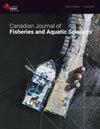通信设备在估算围网船队捕捞作业量方面的潜力
IF 2.2
2区 农林科学
Q2 FISHERIES
Canadian Journal of Fisheries and Aquatic Sciences
Pub Date : 2024-06-18
DOI:10.1139/cjfas-2023-0291
引用次数: 0
摘要
加拿大渔业和水产科学杂志》,提前印刷。 捕鱼对海洋环境有重大影响,而量化这种影响需要精确的捕鱼努力量数据。本研究探讨了准确估算围网渔船捕捞作业量所面临的挑战,并提出了一种利用渔船队实时通讯设备收集的记录进行估算的解决方案。基于高频 GPS 数据的渔捞努力量估算可通过船上可视记录进行验证。此外,通过将船队中的船只联系起来,该方法还可利用运输船(运输鱼类的船只)的信息来加强估算。通过使用广义相加模型,本研究有效地估算了日本围网渔船的捕捞作业量,证明了其准确性。此外,通过纳入承运商信息,基于匹配记录的模型被证明比仅基于渔船或承运商记录的模型具有更优越的预测性能。这些发现为这一方法为可持续渔业管理提供精确和具有成本效益的信息奠定了基础。全球定位系统设备的可负担性和各种船队对通信设备的共同要求进一步支持了实施这种方法的可行性。本文章由计算机程序翻译,如有差异,请以英文原文为准。
Potential of communication devices for estimating the fishing effort of purse seine fleets
Canadian Journal of Fisheries and Aquatic Sciences, Ahead of Print.
Fishing impacts the marine environment significantly, and quantifying this impact requires precise fishing effort data. This study explores the challenges associated with accurately estimating fishing effort by purse seiners and proposes a solution using records collected from real-time communication devices on fishing fleets. The estimation of fishing effort based on high-frequency GPS data can be verified with the onboard visual records. Additionally, by linking vessels within a fleet, the method utilizes information from carriers (vessels that transport fish) to enhance the estimation. Through the use of generalized additive models, this study effectively estimates the fishing effort of Japanese purse seiners, demonstrating their accuracy. Furthermore, by incorporating carrier information, models based on matched records prove to have superior predictive performance compared to those based on fishing vessel or carrier records alone. These findings lay the foundation for the potential of this approach to provide precise and cost-effective information for sustainable fishery management. The affordability of GPS devices and the common requirement of communication devices across various fleets further support the feasibility of implementing this approach.
Fishing impacts the marine environment significantly, and quantifying this impact requires precise fishing effort data. This study explores the challenges associated with accurately estimating fishing effort by purse seiners and proposes a solution using records collected from real-time communication devices on fishing fleets. The estimation of fishing effort based on high-frequency GPS data can be verified with the onboard visual records. Additionally, by linking vessels within a fleet, the method utilizes information from carriers (vessels that transport fish) to enhance the estimation. Through the use of generalized additive models, this study effectively estimates the fishing effort of Japanese purse seiners, demonstrating their accuracy. Furthermore, by incorporating carrier information, models based on matched records prove to have superior predictive performance compared to those based on fishing vessel or carrier records alone. These findings lay the foundation for the potential of this approach to provide precise and cost-effective information for sustainable fishery management. The affordability of GPS devices and the common requirement of communication devices across various fleets further support the feasibility of implementing this approach.
求助全文
通过发布文献求助,成功后即可免费获取论文全文。
去求助
来源期刊

Canadian Journal of Fisheries and Aquatic Sciences
农林科学-海洋与淡水生物学
CiteScore
4.60
自引率
12.50%
发文量
148
审稿时长
6-16 weeks
期刊介绍:
The Canadian Journal of Fisheries and Aquatic Sciences is the primary publishing vehicle for the multidisciplinary field of aquatic sciences. It publishes perspectives (syntheses, critiques, and re-evaluations), discussions (comments and replies), articles, and rapid communications, relating to current research on -omics, cells, organisms, populations, ecosystems, or processes that affect aquatic systems. The journal seeks to amplify, modify, question, or redirect accumulated knowledge in the field of fisheries and aquatic science.
 求助内容:
求助内容: 应助结果提醒方式:
应助结果提醒方式:


